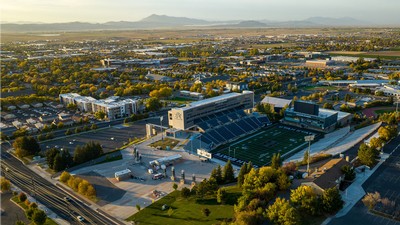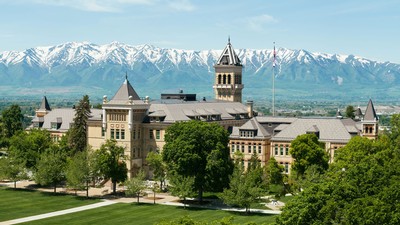Rethinking Stormwater
Researchers at USU will receive EPA funding to study an alternative stormwater management concept.
Researchers at Utah State University are taking a fresh look at stormwater management as part of a federally-funded study to improve water reuse in the western United States.
The team of engineers, scientists and sociologists are among a growing group of water quality experts who say it’s time for new ideas in stormwater management. Their research proposal was chosen among five nationwide to receive part of an Environmental Protection Agency grant totaling $3.3 million. USU will receive $774,283.
Quick Read
|
Chief researcher Ryan Dupont, a professor of civil and environmental engineering, says the goal of the study is to determine the feasibility of recharging underground aquifers with stormwater. Instead of discharging the water into irrigation canals or natural waterways, it’s possible to harvest stormwater at multiple locations and use it to recharge aquifers.
“The conventional thinking for stormwater management is: you collect it, you put it in a pipe and then move it to some location where it’s discharged into the environment,” said Dupont. “Our proposal would be to slowly substitute all the concrete and underground pipes with a more natural, more decentralized system that allows us to reuse the water and minimize contamination.”
Decentralizing the infrastructure is a key component to the study. Stormwater systems used in today’s urban centers collect water and transport it, in most cases, to a single discharge location. This method generates unwanted spikes in water flow and pollutant levels at the discharge sites and has been shown to disrupt natural ecosystems.
“All the stormwater goes to a central location that essentially gets overwhelmed by large quantities of stormwater” said Dupont. “So instead of piping the water to one place, our team is proposing a network of distributed infiltration systems. This diversifies the network and eliminates the high flow and pollutant loading at a single discharge site.”
Such a system could be made up of hundreds or even thousands of small treatment and infiltration systems. Dupont says some cities in the West are already using a similar concept in which stormwater is collected and infiltrated — with minimal treatment — directly into deep groundwater via numerous small wells rather than being piped to a single terminal surface water location.
Dupont and co-researcher Joan McLean, an associate research professor of civil and environmental engineering, are focusing their efforts on how these proposed channels could be constructed and how they would work. Co-researcher Richard Peralta, also a professor of civil and environmental engineering, will look at how infiltrated water will flow and how pollutants could be mitigated in a managed aquifer recharge system.
Co-researcher and professor of sociology Douglas Jackson-Smith is working with the group to assess stakeholder and public attitudes about this new approach to stormwater management. And co-researcher Sarah Null, an assistant professor of watershed sciences, will study the possible ecological benefits of the proposed system.
Related links:
USU Civil and Environmental Engineering Department
Researcher contacts:
Dr. Ryan Dupont, Dept. of Civil and Environmental Engineering, 435-797-3227, ryan.dupont@usu.edu
Dr. Douglass Jackson-Smith, Dept. of Sociology, Social Work and Anthropology, 435-797-0582, doug.jackson-smith@usu.edu
Prof. Joan McLean, Dept. of Civil and Environmental Engineering, 435-797-3199, joan.mclean@usu.edu
Dr. Sarah Null, S.J. & Jessie E. Quinney College of Natural Resources, 435-797-1338, sarah.null@usu.edu
Dr. Richard Peralta, Dept. of Civil and Environmental Engineering, 435-797-2786, peralta.rc@gmail.com
Writer: Matt Jensen, matthew.jensen@usu.edu, 435-797-8170
Cities across the West are exploring alternative stormwater management solutions. In Logan, Utah, a 'curb cut' is used to divert stormwater onto a grassy area. The water moves through the root zone and eventually into groundwater.
TOPICS
Research 898stories Water 266stories Grants 234stories Sociology 51storiesComments and questions regarding this article may be directed to the contact person listed on this page.








